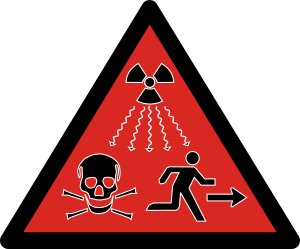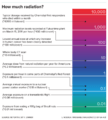Ionizing radiation facts for kids

Ionizing radiation is made of tiny particles or waves that carry a lot of energy. This energy can remove electrons from atoms, which is called ionization. When atoms lose electrons, they become ions, which are atoms with an electrical charge.
The strength of ionizing radiation depends on the energy of the individual particles or waves, and not a function of the number of particles or waves present.
Ionizing radiation can be electromagnetic radiation or subatomic particles. Electromagnetic:
- Gamma rays are electromagnetic waves of highest energy.
- X-rays are less energetic.
- Ultraviolet radiation only ionizes some materials.
Subatomic particle radiation includes:
- Alpha particle radiation, made of helium nuclei
- Beta particle radiation, made of energetic electrons or positrons
- Neutron radiation, made of neutrons
Some radiation can go through the human body and other objects. Usually when people use the term radiation, they are talking specifically about potentially harmful types of ionizing radiation. If something produces this sort of radiation, we can say it is radioactive.
There is a little radiation all around us all the time, which people's bodies are used to, but larger amounts of radiation can make people sick or kill them. Natural ionizing radiation is produced by radioactive decay of some chemical elements, such as uranium. Stars and other things in outer space also make radiation. Some isotopes that are radioactive only stay radioactive for much less than a second. Other things can stay radioactive for thousands of years.
People and anything that lives gives off radiation naturally, because of the potassium and Carbon-14 inside.
Some of the machines that make radiation are called particle accelerators. Scientists use these machines to make radiation so they can study it.
Contents
Natural Sources of Ionizing Radiation
We are exposed to ionizing radiation every day from natural sources around us. This is called background radiation.
- Cosmic Rays: These come from the sun and stars in outer space. When they enter Earth's atmosphere, they create secondary cosmic particles.
- Terrestrial Radiation: This comes from radioactive elements in the soil, water, and air, such as uranium and radon. Radon is a radioactive gas that can seep into homes from the ground.
- Radioactive Isotopes: Some elements like potassium and carbon-14 are naturally radioactive and are found in our bodies and the food we eat.
Man-Made Sources of Ionizing Radiation
Humans have also created sources of ionizing radiation that are used in many helpful ways.
- Medical X-rays: Doctors use X-rays to see inside our bodies and diagnose illnesses or injuries.
- Nuclear Power Plants: These plants use nuclear fission to create electricity. Nuclear fission is when atoms are split apart, releasing energy and radiation.
- Industrial Uses: Radiation is used in factories to measure the thickness of materials, sterilize equipment, and inspect welds.
- Consumer Products: Some products like smoke detectors use small amounts of ionizing radiation to work.
Uses
Ionizing radiation has many important uses in different fields:
Medicine
Ionizing radiation is very important in medicine for diagnosing and treating diseases.
Diagnostic Radiology
- X-rays: Used to take pictures of bones and other dense tissues.
- CT Scans: Provide detailed images of the inside of the body by taking X-rays from many different angles.
- Fluoroscopy: Uses X-rays to create real-time moving images of the body, like watching a video.
- Nuclear Medicine: Uses radioactive substances called radiopharmaceuticals to diagnose and treat diseases. These substances are taken up by specific organs or cells, allowing doctors to see how they are working.
- PET Scans: Use radioactive tracers to show how tissues and organs are functioning at a cellular level.
Radiation Therapy
Ionizing radiation is used to treat cancer by killing cancer cells. This can be done with external radiation (from a machine outside the body) or internal radiation (by placing radioactive materials inside the body near the tumor). Radiation therapy works by damaging the DNA of cancer cells, which stops them from growing and dividing. It can be used as a primary treatment, to shrink tumors before surgery, or to kill any remaining cancer cells after surgery.
Industry
Ionizing radiation is used in many industrial processes to improve efficiency and safety.
Non-Destructive Testing
Radiography: Uses X-rays or gamma rays to inspect materials and structures for defects, like cracks or weaknesses. This is used to check welds, pipelines, and aircraft parts.
This method helps to ensure that products are safe and reliable without damaging them.
Gauges
Radioactive materials are used in gauges to measure the thickness, density, and level of materials. For example, they can measure the thickness of paper, plastic, and metal sheets during manufacturing. They can also measure the level of liquids in tanks and the density of soil at construction sites.
Sterilization
Ionizing radiation is used to sterilize medical equipment, food, and other products by killing bacteria, viruses, and other harmful microorganisms. This is especially useful for items that cannot be sterilized with heat or chemicals. Food irradiation helps to keep food fresh longer by reducing spoilage and preventing foodborne illnesses.
Agriculture
Ionizing radiation helps to improve food production and protect crops.
Plant Breeding
Seeds are exposed to radiation to create new and improved varieties of plants. This can lead to plants that are more resistant to diseases, produce higher yields, or have other desirable traits.
Pest Control
Radiation is used to control insect populations by sterilizing male insects. These sterile insects are released into the wild, where they mate with female insects but do not produce offspring. This helps to reduce the population of harmful insects without using pesticides.
Research
Ionizing radiation is used in many types of research to study the world around us.
Biomedical Research
Radioactive tracers are used to study biological processes in cells, tissues, and organs. This helps scientists understand how the body works and how diseases develop. It is also used to develop new diagnostic and therapeutic methods.
Material Science
Radiation is used to study the structure and properties of materials. This helps scientists to create new materials with improved characteristics for various applications.
Archaeology
Carbon-14 dating is used to determine the age of ancient artifacts and fossils. This helps archaeologists to learn about the history of humans and the Earth.
Energy Production
Ionizing radiation is used in nuclear power plants to produce electricity.
Nuclear power is a reliable and abundant source of energy, but it also produces radioactive waste that must be carefully managed.
Safety Measures
Because ionizing radiation can be harmful, it's important to take safety measures to protect people and the environment.
- Time: Limiting the amount of time spent near a radiation source reduces the dose received.
- Distance: Increasing the distance from a radiation source reduces the intensity of the radiation.
- Shielding: Using barriers like lead, concrete, or water to absorb radiation.
- Regulations: Governments and organizations have rules and guidelines to control the use of ionizing radiation and protect workers and the public.
- Monitoring: Devices like Geiger counters and dosimeters are used to detect and measure radiation levels.
Potential Risks
Exposure to high levels of ionizing radiation can cause health problems.
- Cell Damage: Ionizing radiation can damage the cells in our bodies, which can lead to various health effects.
- Radiation Sickness: High doses of radiation can cause radiation sickness, which includes symptoms like nausea, vomiting, fatigue, and hair loss.
- Cancer: Exposure to ionizing radiation can increase the risk of developing cancer over time.
- Genetic Effects: Radiation can also damage DNA, which can lead to genetic mutation s that can be passed on to future generations.
Interesting facts about ionizing radiation
- Most materials on Earth contain some radioactive atoms, even if in small quantities.
- The global average exposure of humans to ionizing radiation is about 3 mSv (0.3 rem) per year, 80% of which comes from nature. The remaining 20% results from exposure to human-made radiation sources, mainly medical imaging.
- Average human-made exposure is much higher in developed countries, mostly due to CT scans and nuclear medicine.
- Medical procedures, such as diagnostic X-rays, nuclear medicine, and radiation therapy are by far the most significant source of human-made radiation exposure to the general public.
- The public is also exposed to radiation from consumer products, such as tobacco (polonium-210), combustible fuels (gas, coal, etc.), televisions, luminous watches and dials (tritium), airport X-ray systems, smoke detectors (americium), electron tubes, and gas lantern mantles (thorium).
- The cosmic-radiation dose rate on airplanes is so high that, according to the United Nations UNSCEAR 2000 Report (see links at bottom), airline flight crew workers receive more dose on average than any other worker, including those in nuclear power plants.
- The International Commission on Radiological Protection recommends limiting artificial irradiation to the public to an average of 1 mSv (0.001 Sv) of effective dose per year, not including medical and occupational exposures.
- Hazardous levels of ionizing radiation are signified by the trefoil sign on a yellow background.
Related pages
Images for kids
-
Cloud chambers are used to visualise ionizing radiation. This image show the tracks of particles, which ionise saturated air and leave a trail of water vapour.
-
Ionized air glows blue around a beam of particulate ionizing radiation from a cyclotron
See also
 In Spanish: Radiación ionizante para niños
In Spanish: Radiación ionizante para niños






